Grape (Vitis)
Plant Health Problems
Diseases caused by Fungi:
Black rot, Guignardia bidwellii.Black rot is probably the most serious disease of grapes in Connecticut. This fungus can infect all green parts of the vine including leaves, tendrils, new shoots, as well as berries. However, mature leaves and ripe fruit are not susceptible. Infections of leaves first appear as red spots on the upper leaf surface in late spring. These circular spots enlarge and become tan to light brown with distinct, dark borders. Small, pinpoint black fruiting structures of the fungus often develop in the centers of these spots. Most serious damage usually occurs on the berries. On the fruit, infections first appear as whitish spots which enlarge to sunken areas with dark borders. Significant infections usually occur when the grape is pea-size or larger. As infection progresses, the fruit become black, wrinkled, mummified, and look like raisins. Infected grapes often shatter, leaving only the stem. The fungus overwinters on mummified berries on the soil or in old clusters still hanging in the vines.
Sanitation is essential to control black rot. Infected mummies on the vine or infected twigs or shoots should be removed, pruned, or destroyed. In addition, all mummies on the soil should be disked or buried. These steps eliminate significant amounts of overwintering inoculum of the fungus. In conjunction with sanitation, a season-long fungicide program is usually necessary for effective black rot control, especially if infection was severe the previous year. Among the compounds registered for use in Connecticut are ferbam, fenarimol, myclobutanil, and mancozeb. Consult the label for dosage rates, safety precautions, and days to harvest intervals. For more information, see the fact sheet on Disease Control for the Home Grape Planting.
Downy mildew, Plasmopora viticola.
Downy mildew is often a problem during warm, wet years. The fungus is an obligate pathogen which can attack all green parts of the vine. Symptoms of this disease are frequently confused with those of powdery mildew. Infected leaves develop pale yellow-green lesions which gradually turn brown. Severely infected leaves often drop prematurely. Infected petioles, tendrils, and shoots often curl, develop a shepherd's crook, and eventually turn brown and die. Young berries are highly susceptible to infection and are often covered with white fruiting structures of the fungus. Infected older berries of white cultivars may turn dull gray-green, whereas those of black cultivars turn pinkish red. The fungus overwinters mainly in the fallen leaves. The most serious outbreaks have been found to occur when a wet winter is followed by a wet spring and a warm summer with intermittent rains.
Sanitary practices such as pruning of infected shoots and raking and removing fallen leaves help to reduce overwintering inoculum. Cultural practices which promote and encourage good air drainage are also important. In addition, cultivars vary in susceptibility: V. vinifera is highly susceptible, V. aestivalis and V. labrusca are less susceptible, and V. cordifolia, V. rupestris, and V. rotundifolia are relatively resistant. However, in years of favorable conditions for disease, chemical controls are often necessary. Among the compounds registered for use in Connecticut is mancozeb. Consult the label for dosage rates, safety precautions, and days to harvest intervals. For more information, see the fact sheet on Disease Control for the Home Grape Planting.
Powdery mildew, Uncinula necator.
Powdery mildew can infect all green tissues of the grapevine. Tissues are generally susceptible to infection throughout the growing season. This disease is often confused with downy mildew. Diseased leaves appear whitish gray, dusty, or have a powdery white appearance. Petioles, cluster stems, and green shoots often look distorted or stunted. Berries can be infected until their sugar content reaches about 8%. If infected when young, the epidermis of the berry can split and the berries dry up or rot. When older berries are infected, a netlike pattern often develops on the surface of the berry. The powdery mildew fungus overwinters in dormant buds or as specialized structures on the surface of the vines. When conditions are favorable for growth of the fungus in spring, spores are produced, released, and cause new infections. Secondary spread of the disease can occur if spores are produced in these new infections. It is important to note that moisture is not necessary for infection so this disease can be serious during relatively dry years.
Cultural practices that contribute to increased air circulation (e.g., row orientation, pruning and training practices, site selection) may reduce the severity of the disease. In addition, Vitis species also differ in their susceptibility to this disease: V. vinifera is highly susceptible whereas V. cinerea, V. labrusca, and V. riparia are much less susceptible. If infection was heavy the previous year and conditions are favorable for disease, fungicide sprays are often needed for control. Among the compounds registered for use in Connecticut are fenarimol, myclobutanil, potassium bicarbonate, and wettable sulfur. Consult the label for dosage rates, safety precautions, and days to harvest intervals. For more information, see the fact sheet on Disease Control for the Home Grape Planting.
Diseases caused by Physiological/Environmental Factors:
2,4-D injury, misapplied pesticide.
The use of 2,4-D herbicides on lawns can pose a problem for grapes. Since grapes are highly susceptible to 2,4-D compounds, vines can be injured from drift or by using the same sprayer for spraying other pesticides on the grape vines. Symptoms of injury include stunting of the leaves and extensive proliferation of the veins and elimination of the lobes, a condition which gives the leaf a palmleaf fan appearance.
Prevention is the best strategy for control.
Insect Problems:
Cottony maple scale, Pulvinaria innumerabilis.
This scale is often found on grape although it does not cause serious injury. This is a brown, oval, soft scale on the bark in winter, but in June the large egg masses are formed, and their wax covering resembles a tuft of cotton. The young crawl in July and some of them live for a time on the leaves, but return to the twigs to pass the winter. Ultrafine oil, which is among the compounds registered for use against this pest in Connecticut, sprayed on foliage will control it. Consult the label for dosage rates, safety precautions, and preharvest intervals.
Eightspotted forester, Alypia octomaculata.
The larvae of this insect often feed on grape leaves, sometimes stripping the vines. Caterpillars are cross-banded with black, white, and orange. The adult is a black moth with wingspread of from 1 1/4 to 1 1/2", with two pale yellow spots on each forewing and two white spots on each rear wing. The insect winters as a pupa in the soil, and there is only one generation each year in Connecticut. Handpicking is the only control needed, except occasionally when the insect is very abundant, in which case a spray of Bacillus thuringiensis var. aizawai should be effective. This material is registered for control of this pest in Connecticut; consult the label for dosage rates, safety precautions, and preharvest intervals.
European fruit lecanium, Parthenolecanium corni.
This scale that infests many different kinds of trees and shrubs often occurs on grape vines. These convex scales are considerably larger than San Jose or Forbes scales. They are rare in Connecticut and control usually is not required.
Grape berry moth, Paralibesia viteana.
The grape berry moth is the cause of most wormy grapes. There are three generations each year. The insect always passes the winter in the cocoon stage on fallen damp and decaying leaves. The moths emerge the first of June and lay eggs on the stems of the blossom clusters. Young caterpillars web together and partially devour the buds and blossoms. They continue feeding on the blossoms and newly-set berries, becoming fully grown about July 1, when they are about 3/8" long. Caterpillars vary in color from dark green to purple, with a light brown head. They then cut peculiar flaps in the leaf and fold them to form a cocoon or case in which to pupate. In two weeks the moths, which have a half-inch wingspan, emerge. The moths are purplish-brown in color with darker markings on the forewings. These moths lay eggs on the green berries, in which the young larvae burrow and feed during July and August. Infested berries often show purplish spots and sometimes crack open. A larva may leave one berry and enter a second and third berry, fastening them together with a few silk threads. This second generation of caterpillars does the greatest damage. The third generation larvae feed during September, sometimes in the ripening fruit.
One control measure is to remove nearby wild grape plants that can be a source of reinfestation. Cultivating between the rows in the fall buries overwintering larvae. Bagging the clusters in the small garden will protect them from injury. If needed, methoxychlor or carbaryl, which are among the compounds registered for control of this pest in Connecticut, can be sprayed on the blossom clusters after bloom, ten days later and again in late July or early August. Consult the labels for dosage rates, safety precautions, and preharvest intervals.
Grape cane girdler, Ampeloglypter ater.
The small larvae tunnel in canes, causing death of the terminal portion. The eggs are laid by a small black weevil. There is little real damage except unsightly vines. Sprays for other pests usually control girdlers.
Grape flea beetle, Altica chalybea.
This is a glossy greenish-blue leaf beetle, less than 1/5" long, which eats the buds of the grapevine just as growth begins. It has caused severe injury in limited areas in the eastern half of the United States. The female beetles lay eggs under the edges of loose bark, and the young grubs feed on the upper surface of the leaves in June and July, partially skeletonizing them. The adult beetles overwinter under loose bark, trash, or wherever they can find protection. There is a single generation each year. Where needed, methoxychlor or carbaryl, which are among the compounds registered for control of this pest in Connecticut, can be sprayed on buds just before they swell. Consult the label for dosage rates, safety precautions, and preharvest intervals.
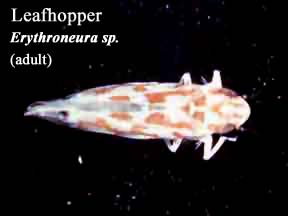
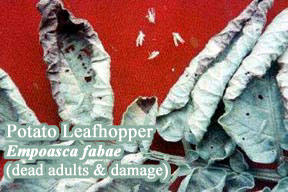 Grape leafhopper, Erythroneura comes and potato leafhopper, Empoasca fabae.
Grape leafhopper, Erythroneura comes and potato leafhopper, Empoasca fabae.
Both nymphs and adult leafhoppers suck sap from the undersides of the leaves, which soon turn brown. There are two generations each year. In late fall, the adults seek protection in woodlands, brush, weed, or grass areas, where they pass the winter. The white adult is only 1/8" long, and is peculiarly marked with yellow and red. When needed, sprays of methoxychlor or diazinon, which are among the compounds registered for use against this pest in Connecticut, applied to the undersides of leaves after flower petals fall, will control both adults and nymphs. Consult the labels for dosage rates, safety precautions, and preharvest intervals.
Grape leaffolder, Desmia funeralis.
The small larvae fold the leaves, fastening them with silken strands, and feed within. The adult moth is dark brown with two white spots on each wing. Spraying with methoxychlor or diazinon, which are among the compounds registered for use against this pest in Connecticut, in June has controlled this pest. Consult the labels for dosage rates, safety precautions, and preharvest intervals.
Grape phylloxera, Phylloxera vitifoliae.
This insect is related to aphids and has two forms. The yellow wingless form causes nodules on the roots. The other causes galls on leaf surfaces. There may be six annual generations of the root form and from five to seven generations of the gall-making form on the leaves. The root form of this insect is extremely destructive to the European varieties derived from Vitis vinifera, and such varieties can be grown here only when grafted on the roots of American grape species. To control the leaf form of grape phylloxera remove and destroy infected leaves.
Grape plume moth, Pterophorus periscelidactylus.
The larva of this moth webs together the tender terminal leaves and feeds inside the nest. It does not injure the shoot but feeds on the leaves. It is light green with white hairs and grows 1/2" long. It matures late in June and the pupa is fastened to a leaf. In a week, a yellowish brown moth with deeply cleft wings or "featherwings" emerges. This insect causes little serious injury. Ultrafine oil, which is among the compounds registered for use against this pest in Connecticut, sprayed on foliage will control it. Consult the label for dosage rates, safety precautions, and preharvest intervals.
Grape rootworm, Fidia viticida.
In some portions of the eastern United States the grape rootworm is considered the most destructive insect pest of the grape. The adult is a small grayish brown leaf beetle, about 1/4" long, which eats peculiar chain-like holes in the leaves in July. The larvae or grubs devour the small root hairs and eat the bark of the larger roots and main stem beneath the surface of the ground. Badly injured vines have yellow leaves that fall prematurely, the fruit withers and drops, and in severe cases, the vines die. The eggs are laid in clusters under the loose bark on the old canes. The young grubs drop to the ground, enter through cracks or crevices and make their way to the roots where they feed for the remainder of the season. They live in the soil as larvae through the winter, then continue feeding in the spring and late in May or early in June and ascend to the upper 2 or 3" of soil to make earthen cells in which they pupate. There is one generation each year. Malathion, which is among the compounds registered for use against this pest in Connecticut, applied as an adulticide should provide some control. Consult the label for dosage rates, safety precautions, and preharvest intervals.
Grape scale, Diaspidiotus uvae.
This scale occurs on the old canes, especially under the edges of the loose bark. It is not very injurious. The shells are circular or somewhat elliptical, gray or yellowish brown, with a pale yellow exuvial spot with a whitish nipple at one side of the center. There is a single generation each year. The winter is passed by the nearly matured females, which complete their development in the spring, and in May and June, give birth to living young. When control is needed, a dormant spray of horticultural oil, which is among the compounds registered for use against this pest in Connecticut, is suggested. Consult the label for dosage rates, safety precautions, and preharvest intervals.
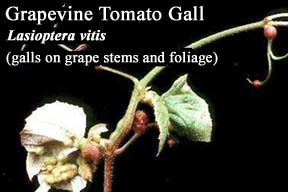 Grapevine tomato gall, Lasioptera vitis.
Grapevine tomato gall, Lasioptera vitis.
This is a swollen or tumid deformation of the new growth that takes many forms and may involve the leaves, tendrils, blossom buds, and the terminal shoot itself. The eggs are laid in the tissues by a midge or small fly and the galls contain cells in which pinkish maggots or larvae develop. There is one generation each year. If necessary, sprays of methoxychlor, which is among the compounds registered for control of this pest in Connecticut, applied as soon as growth starts, should be effective. Consult the label for dosage rates, safety precautions, and preharvest intervals.
Japanese beetle, Popillia japonica.
When abundant, this beetle may cause severe injury by feeding on the tender terminal leaves of grape. Sprays of methoxychlor, carbaryl, azadirachtin or malathion, which are among the compounds registered for control of this pest in Connecticut, early in July protect the foliage. Consult the labels for dosage rates, safety precautions, and preharvest intervals.
Light-loving grapevine beetle, Pachystethus lucicola.
This is a fairly common beetle about 1/4" long, usually with light brown wingcovers without markings. Another form is purplish black. Both forms may be found feeding on grape, Virginia creeper, and sometimes beans. There is one generation each year and the partially grown larvae pass the winter in the soil, where they feed on grass roots. It is only when the insect is abundant that any control measures are necessary.
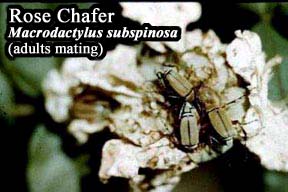 Rose chafer, Macrodactylus subspinosus.
Rose chafer, Macrodactylus subspinosus.
The rose chafer is often a serious pest of grape and sometimes devours the blossom buds, blossoms, and newly set fruit in addition to riddling the leaves. When needed, sprays of malathion, carbaryl, azadirachtin or methoxychlor, which are among the compounds registered for use against this pest in Connecticut, applied when adults are present, will provide control. Consult the labels for dosage rates, safety precautions, and preharvest intervals.
Sphinx caterpillars, Sphecodina abbotii, Ampelophaga myron.
There are several kinds of hornworms or sphinx caterpillars that often feed on grape leaves. Some of these are the abbot sphinx, Sphec ed grapevine beetle, Pelidnota punctata.
This is a light brown glossy, nearly 1" long beetle marked with black spots. The beetles feed on grape and if numerous, may do some damage. Handpicking will provide sufficient control in a small planting.
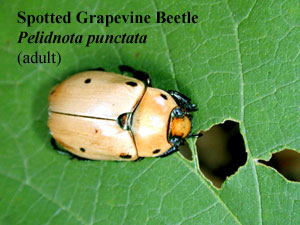 Spotted grapevine beetle, Pelidnota punctata.
Spotted grapevine beetle, Pelidnota punctata.

